A Catalog of Molecular Clumps and Cores with Infall Signatures
Shuling Yu (于书岭) , Zhibo Jiang (江治波),3 , Yang Yang (杨旸) , Zhiwei Chen (陈志维) , and Haoran Feng (冯浩然)
1 Purple Mountain Observatory, Chinese Academy of Sciences, Nanjing 210023, China; zbjiang@pmo.ac.cn
2 University of Science and Technology of China, Chinese Academy of Sciences, Hefei 230026, China
3 Center for Astronomy and Space Sciences, Three Gorges University, Yichang 443002, China
Abstract The research of infall motion is a common means to study molecular cloud dynamics and the early process of star formation.Many works had been done in-depth research on infall.We searched the literature related to infall study of molecular cloud since 1994,summarized the infall sources identified by the authors.A total of 456 infall sources are cataloged.We classify them into high-mass and low-mass sources,in which the high-mass sources are divided into three evolutionary stages:prestellar,protostellar and H II region.We divide the sources into clumps and cores according to their sizes.The H2 column density values range from 1.21×1021 to 9.75×1024 cm-2,with a median value of 4.17×1022 cm-2. The H2 column densities of high-mass and low-mass sources are significantly separated.The median value of infall velocity for high-mass clumps is 1.12 km s-1,and the infall velocities of lowmass cores are virtually all less than 0.5 km s-1. There is no obvious difference between different stages of evolution. The mass infall rates of low-mass cores are between 10-7 and 10-4 M⊙yr-1, and those of high-mass clumps are between 10-4 and 10-1 M⊙yr-1 with only one exception.We do not find that the mass infall rates vary with evolutionary stages.
Key words: stars: formation – ISM: molecules – ISM: kinematics and dynamics – radio lines: ISM
1. Introduction
Infall motion is the initial stage of star formation. Although stars with different masses may have different formation mechanisms (e.g., Cesaroni et al. 2007; Zinnecker &Yorke 2007; Beltrán & de Wit 2016; Klassen et al. 2016),they all start from the collapse and infall of molecular cloud cores. Low-mass stars are believed to formed through insideout gravitational collapse of dense molecular cores(Shu 1987),in which gravity overcomes thermal and nonthermal (mainly magnetic and turbulent)pressure (Zhou et al.1993,1994).For high-mass stars (≥8 M⊙), the formation mechanism is still controversial because of the poverty of samples and the difficulty of observation due to the larger distance of starforming region, stronger interaction with surrounding molecular clouds,and shorter star-forming timescale.There are two dominant models, one is core accretion (McKee &Tan 2002, 2003; Yorke & Sonnhalter 2002), which assumes that massive stars form as their population of low-mass stars in isolation, but that the accretion rate is a few orders of magnitude higher than low-mass stars.Another model is called competitive accretion (Bonnell & Bate 2002; Bonnell et al.2004). This model claims that massive stars form in the dense part of molecular clumps (size ≤1 pc and mass ≥200 M⊙,Beuther et al. 2005; Tan et al. 2014). They compete to accrete materials with other protostars, and the accretion continues until the accretion condition is not satisfied. Some recent observations (e.g., Liu et al. 2013; Peretto et al. 2013;Contreras et al. 2018) support this model. In any case, infall motion is the key to initiating the formation of massive stars and maintaining accretion flows to increase mass continually during subsequent phases of evolution in these two models.
The method of finding infall samples is to identify them through special line profile. One of the significant features of infall motion is called “the spectral line asymmetry” (e.g.,Zhou 1992;Mardones et al.1997;Evans 1999;Lee et al.1999;Wu & Evans 2003; Churchwell et al. 2010), i.e., it shows double peaks profile where the blue peak is stronger than the red one on an optically thick line, while the optically thin line has only a single peak between the double peaks of the optically thick line. The commonly used optically thick lines are CO(1–0), HCO+(1–0), HCO+(4–3), HCN(1–0), CS(2–1),H2CO(2–1), etc. Their isotopic molecular lines, C18O(1–0),H13CO+(1–0), H13CO+(4–3), H13CO+(3–2), H13CN(1–0), are generally used as optically thin line to trace the system velocity.In addition,N2H+(1–0)is generally optically thin,and can characterize the dense inner region of a core and well estimate the system velocity (Mardones et al. 1997; Lee et al.1999), so it is particularly suitable for studying the structure and kinematics of star-forming cores and has been used to detect infall in IRDCs (infrared dark clouds), starless cores and protostar cores (e.g., Lee et al. 2001; Fuller et al. 2005;Keto et al. 2015; Keown et al. 2016; Storm et al. 2016; Kim et al. 2021).
At present,there are good constraints on the formation of lowmass stars,and the corresponding evidence of infall motion has been found in the early stage until class I phase(e.g.,Mardones et al.1997;Gregersen 2000;Lee et al.2001;Lee&Myers 2011;Padoan&Haugbølle 2014;Keown et al.2016;Kim et al.2021).In contrast,due to the controversy on the formation mechanism,the infall observation and research of high-mass young stellar objects (YSOs) has become more popular in recent years (e.g.,Sridharan et al. 2002; Fuller et al. 2005; Klaassen &Wilson 2008; Sun & Gao 2009; Liu et al. 2011, 2013, 2020;Reiter et al.2011;Klaassen et al.2012;Qiu et al.2012;He et al.2016;Qin et al.2016;Cunningham et al.2018;Saral et al.2018;Tang et al.2019;Yang et al.2020b;Yue et al.2021).Rygl et al.(2013) found that the formation are closely related to the“clump-to-cloud”column density ratio.They did not find YSOs in clumps with molecular hydrogen column density less than 4×1022cm-2; this ratio greater than 2 is the first sign of the beginning of star formation, and infall signature can be widely observed at this time; when the ratio greater than 3, the infall motions stop in most clumps. He et al. (2015, 2016) analyzed 732 high-mass clumps, and concluded that the detection rate of infall sources decreases gradually from prestellar to protostar and then to H II region phase;the mass of the clumps increases with these evolutionary stages whether the infall is detected or not.However, Klaassen et al. (2012) came to an abnormal situation that the detection rate of infall candidates increased significantly from protostar to hypercompact H II region phase. He thought this may be related to the beam dilution caused by smaller infall area of younger sources. Yue et al. (2021) observed 30 highmass clumps associated with bright infrared sources, and found that the clumps with higher mass and luminosity tend to have larger mass infall rates.Large sample survey and high resolution observation of interferometric array have become the future trend of infall study.
On the basis of observation and theoretical study,the process of massive star formation is proposed by a number of researchers. Saral et al. (2018) used the classification method summarized by Motte et al. (2018): (1) starless core (Lee et al.2001;Sohn et al.2007;Lee&Myers 2011;Schnee et al.2013),the gravitationally bound prestellar core or IRDC (Contreras et al. 2018); (2) hot molecular core (HMC) or protostar(Mardones et al.1997;Fuller et al.2005;Wu et al.2005;Keown et al.2016);(3)HII region(He et al.2016).An additional stage is defined by Guzmán et al.(2015).At this stage,the expansion of the ionized gas finally destroys the molecular envelope,forming the characteristic of an extended classical H II region and a photodissociation region(PDR).Because H II still exists in this stage,but it is merely more extended,so we incorporate this stage into the stage 3. Therefore, this paper adopts the classification by Motte et al. (2018),which is divided into three main stages: prestellar, protostellar, H II region.
For simplicity, we define an infall source as a source with infall signature in this paper. There is no complete statistical work on infall sources before. Therefore we make a comprehensive search of infall study in the literature,aggregate the infall sources into a catalog, and make some statistical analysis on the physical properties.
2. The Data
2.1. Tracers
Table 1 lists the optically thick and thin lines used to identify the infall signatures collected in this paper.The frequencies and upper level of energies(Eu)in the catalog are obtained from the Splatalogue Database.4https://splatalogue.onlineThe critical density (ncrit) of each molecular transition is calculated by ncrit=Aul/γul,where Aulis the Einstein A-coefficient and γulis the collision rate coefficient for collisions with H2at a certain temperature. The Leiden Atomic and Molecular Database5https://home.strw.leidenuniv.nl/~moldata/(LAMDA, Schöier et al.2005) provides Auland γulat different temperatures. We adopt those which are nearest Eu.Different spectral lines can trace different properties. HCO+is an abundant molecule, with particularly enhanced abundances around higher fractional ionized regions (Vasyunina et al. 2011). HCN is a good tracer of infall motion in the lowmass star-forming region. However, it may become unreliable because of a higher level of turbulence (Redman et al. 2008)and outflow signatures (Zhang et al. 2007) for the high-mass cores (Vasyunina et al. 2011). HNC is also a commonly used infall tracer.The abundance ratio HCN/HNC strongly depends on the temperature, it decreases from decades near the warm core to ~1 on the colder edges (Sarrasin et al. 2010).Table 2 lists the number of sources observed by each spectral line. The upper part is the optically thick line. About 77% of the infall sources are identified with HCO+(1–0), HNC (1–0)is the second most (28%). This may be because HCO+(1–0)and HNC (1–0) have moderate critical density, which are high enough to trace the dense part closer to the core,and are not as high as CS (2–1), which makes it difficult to achieve such environmental conditions. In addition, the frequencies of HCO+(1–0) and HNC (1–0) fall in one of the best windows of atmospheric transparency, allowing them to be easily observed. Smith et al. (2013) modeled the emission produced by the hydrodynamic simulation of collapsing clouds in massive star-forming regions without outflows, and concluded that HCO+(1–0) is better performed to trace collapse than HCO+(4–3). Some infall studies (e.g., Fuller et al. 2005;Vasyunina et al. 2011; Rygl et al. 2013; Cunningham et al.2018;Yuan et al.2018;Zhang et al.2018)that simultaneously observe multiple optically thick lines seem to support HCO+(1-0) as a more effective tracer. But note that this may not bealways true,for example,Tsamis et al.(2008)show that HCO+(4-3) may be a better tracer to detect the asymmetry than HCO+(1-0) at earlier times.
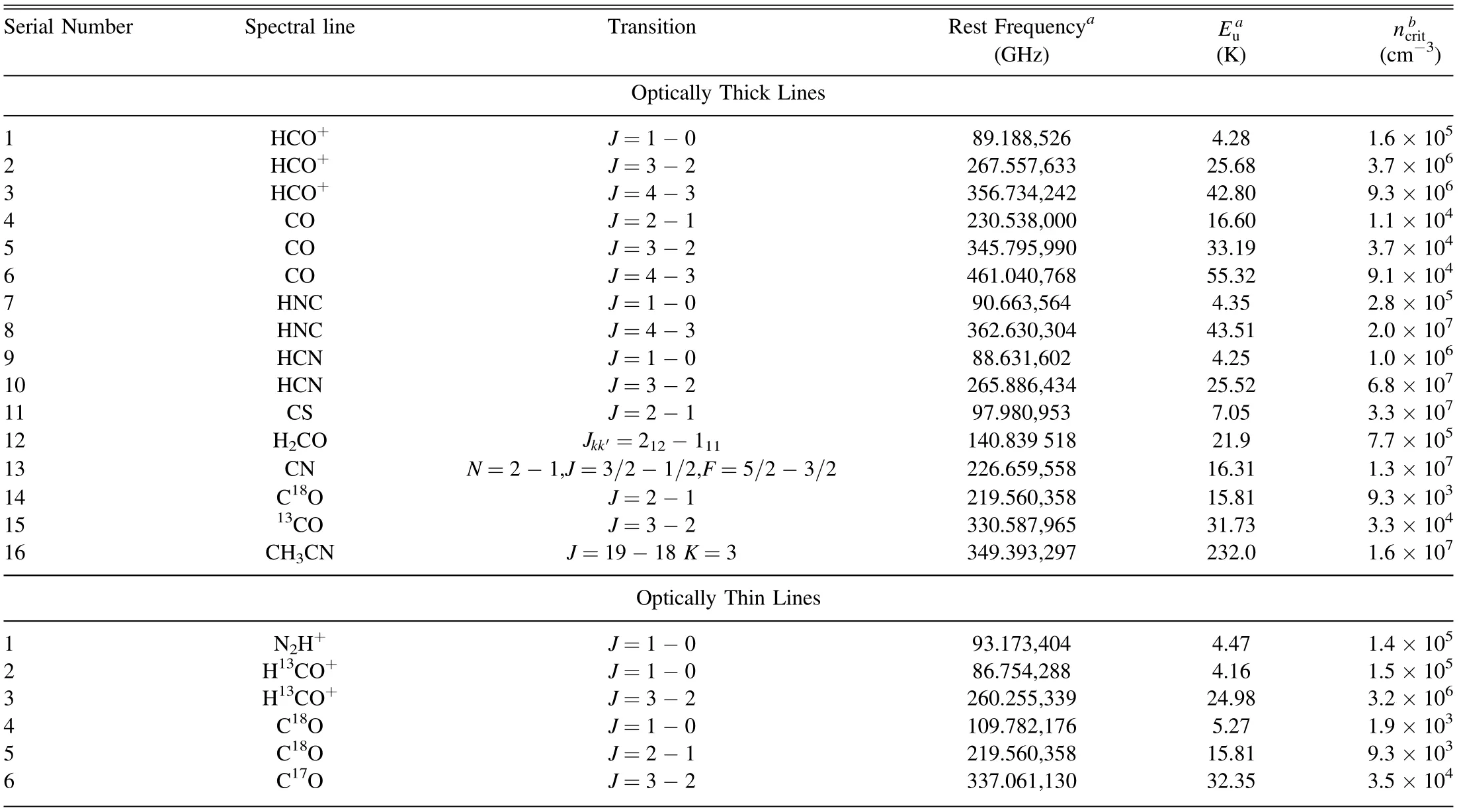
Table 1 Tracers Used in the Literature
The observation of optically thin lines is also particularly crucial. Multiple velocity component, for example, the colliding fragments of two clouds, could produce the doublepeaked blue profile, but they would also produce a doublepeaked profile in the optically thin line (Evans 1999). In order to eliminate this situation,the optically thin line must have only a single peak between the two peaks of the optically thick line.The lower part of Table 2 lists the optically thin lines used in the articles. Different line widths of optically thin lines will affect the estimation of skewness parameters, see Section 3.4.
2.2. The Catalog
Up to May 2021, a total of 456 infall candidates have been identified, including 352 (77%) sources being associated with high-mass star-forming regions, and 55 (12%) with low mass,the remaining 49(11%)being uncertain.The low-mass sources are fewer, probably due to the more attention has been paid to high-mass sources in recent years, meanwhile the weakness of infall characteristics of low-mass sources. Of these sources,eight are observed by interferometric array, accounting for a small proportion and will not be discussed separately, the others are observed by single-dish telescope.
We divide the sources into clumps and cores as their properties may be different in infall motion. He et al. (2015)counted the sources and found that more than 96.6 per cent of clumps have masses higher than 100 M⊙. Saral et al. (2018)thought that the dense cores have sizes <0.1 pc and masses<100 M⊙. This paper adopts such a grouping criterion: when the radius of a source lower than 0.1pc(main criteria)and mass lower than 100 M⊙,we believe this source is a core,otherwise,it is classified as a clump. For those sources whose radius data are not given in the literature, we use the calculated distance and the spatial resolution of the telescope to estimate the radius.Of all the 456 sources,396(87%)are clumps and 60(13%)are cores. For 352 high-mass sources, 343 (97%) are clumps, and for 54 low-mass sources, 46 (85%) are cores. That is, vast majority of the high-mass sources are clumps, and most of the low-mass sources are cores.Therefore,we ignore the influence of these few parts and only discuss the statistical properties of high-mass clumps and low-mass cores. The difference of statistical results is less than 5%when the samples are roughlydivided into high-mass and low-mass sources compared with which are grouped into clumps and cores.
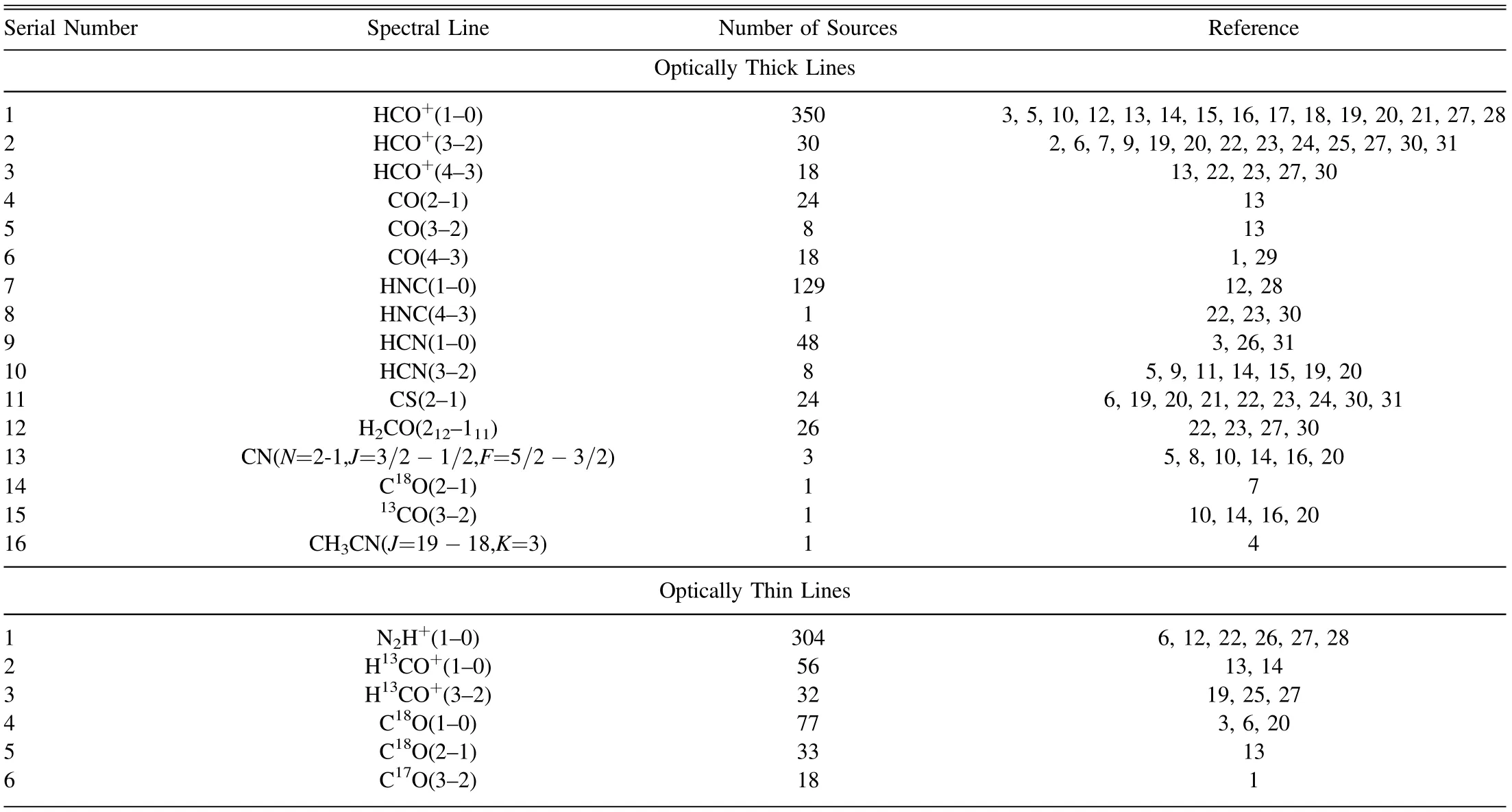
Table 2 The Number of Sources Observed by Tracers
Table 3 lists the first ten sources of the infall catalog and their physical parameters. The complete catalog is in table A.1 of the Appendix. All the parameters are fetched from the literature, except the distance.
3. Statistics and Distribution
3.1. Spatial Distribution
Figure 1 shows the galactic distribution of all infall sources overlaid on the imaginary face-on image of the Milky Way,which is adopted from “Xing-Wu Zheng & Mark Reid BeSSeL/NJU/CFA6https://astronomy.nju.edu.cn/xtzl/EN/”, and which is believed to be currently the most scientifically accurate visualization of the Milky Way.The blue circle indicates the location of the Sun,with a distance 8.15 kpc to the Galactic center (Reid et al. 2019). The red pentagram represents the location of the infall sources. The scale of the image is indicated in the lower left corner of the figure. We found that most of the sources (about 90%) are located within 5 kpc of the Sun. This may be caused by the observation effect. Moreover, The numbers of infall sources inside and outside the solar circle are 390 and 66,respectively.Although the observations to date are far from complete, the present evidence shows that the star formation activity inside the solar circle is more intense than the outside (Djordjevic et al. 2019), which needs further investigation in the future.Some infall sources are distributed on the spurs between the Local and Sagittarius arms (Xu et al. 2016) and between the Sagittarius and Scutum arms.
3.2. Excitation Temperature
The excitation temperature Texis usually estimated using the standard radiation transfer equation and assuming local thermodynamic equilibrium (LTE).
Of all the sources, there are 109 that have valid Texvalues,all of them are fetched from the literature. we do not differentiate these sources by high mass or low mass because of the relatively small number. The median and mean value of Texare 12.3 K and 13.4 K respectively. Figure 2(a) shows the distribution of Texof all, and (b) shows the distribution of Texof each stage.It can be seen from Figure 2(b)that the excitation temperatures in the protostar stage are significantly higher than those in the prestellar stage,and their median values are 17.1 K and 7.8 K respectively.It may be because of the fact that in the prestellar stage, it is too early to release enough gravitational energy to heat the surrounding environment. However, this trend should be interpreted with caution due to the small number of samples.

Table 3 The Catalog of all Collected Infall Sources
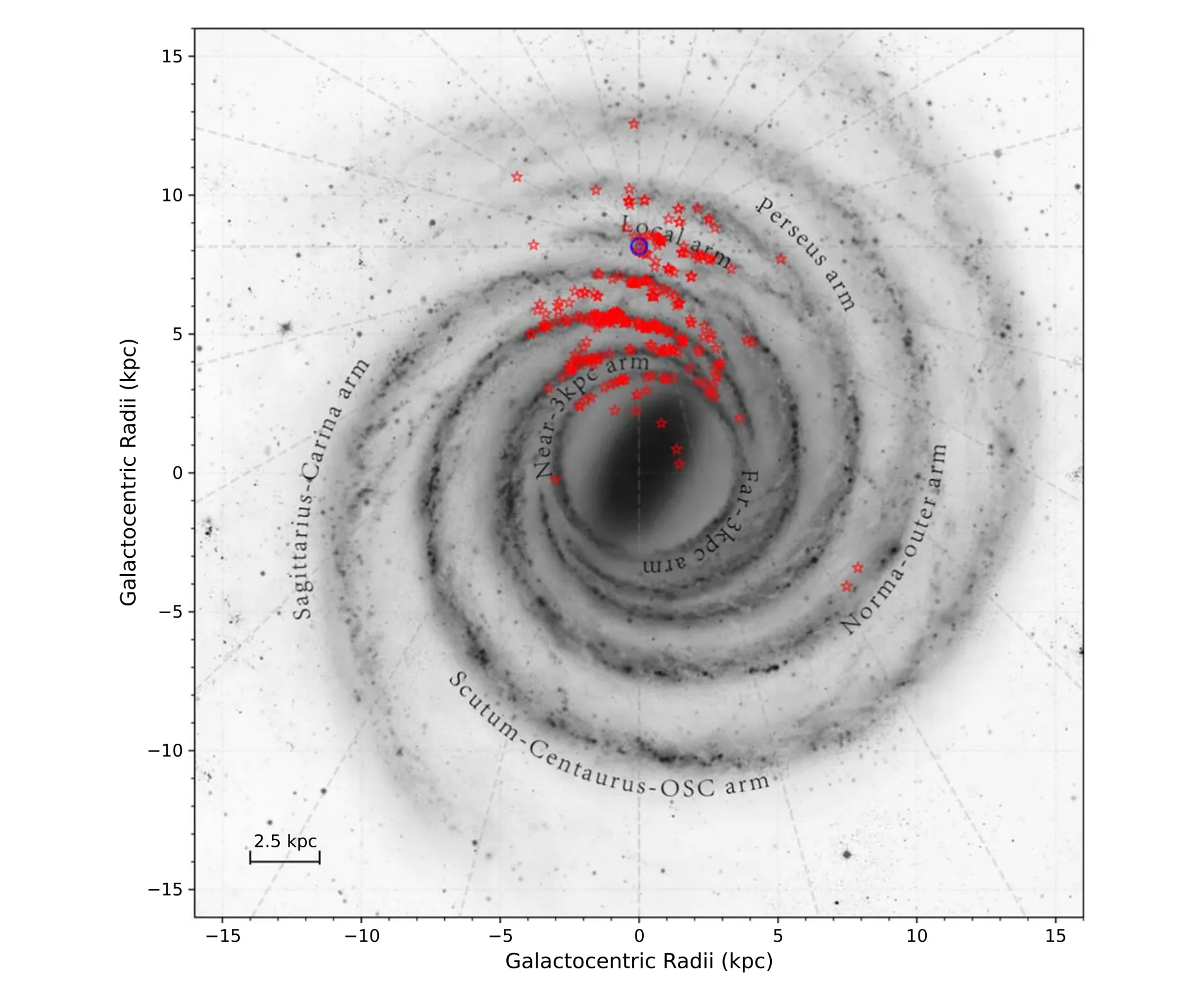
Figure 1.Galactic distribution of the infall sources.The blue circle indicates the location of the Sun.The red pentagram represents the location of the infall sources.The background is the imaginary face-on image of the Milky Way (created: “Xing-Wu Zheng & Mark Reid BeSSeL/NJU/CFA”).
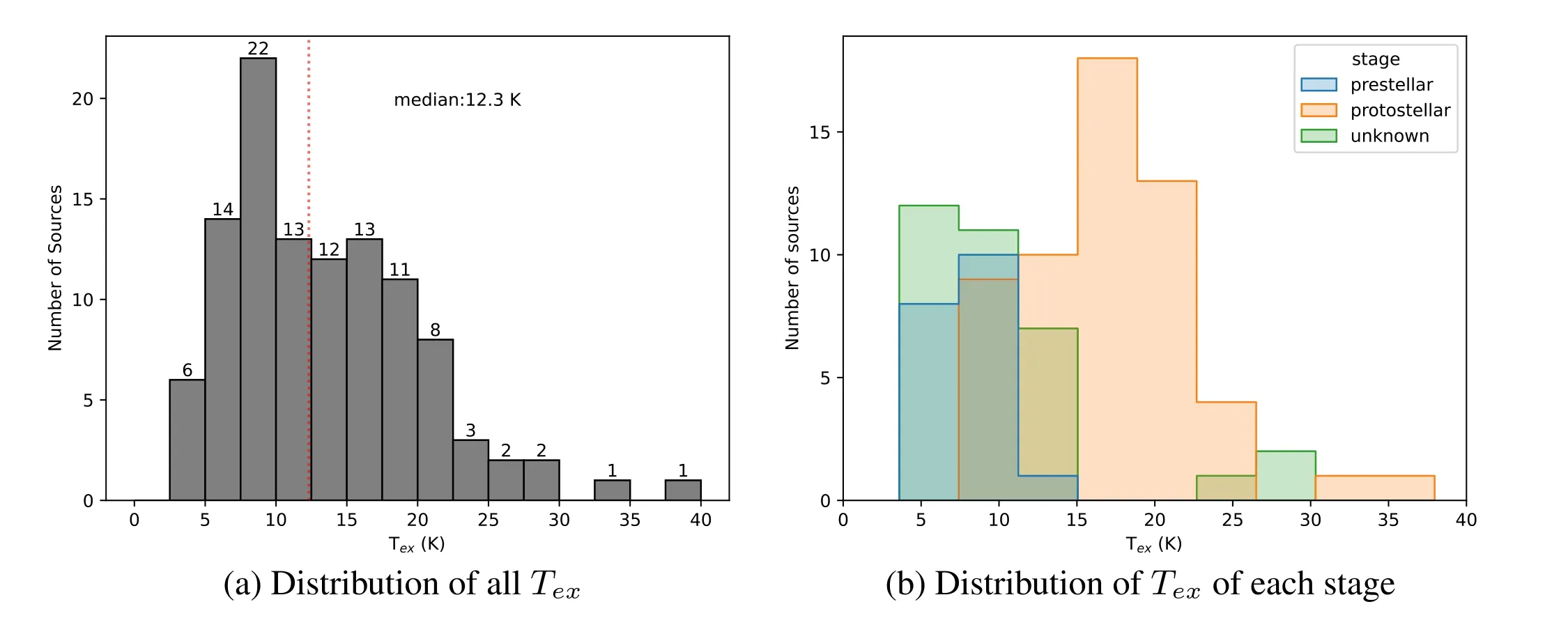
Figure 2. Distribution of Tex
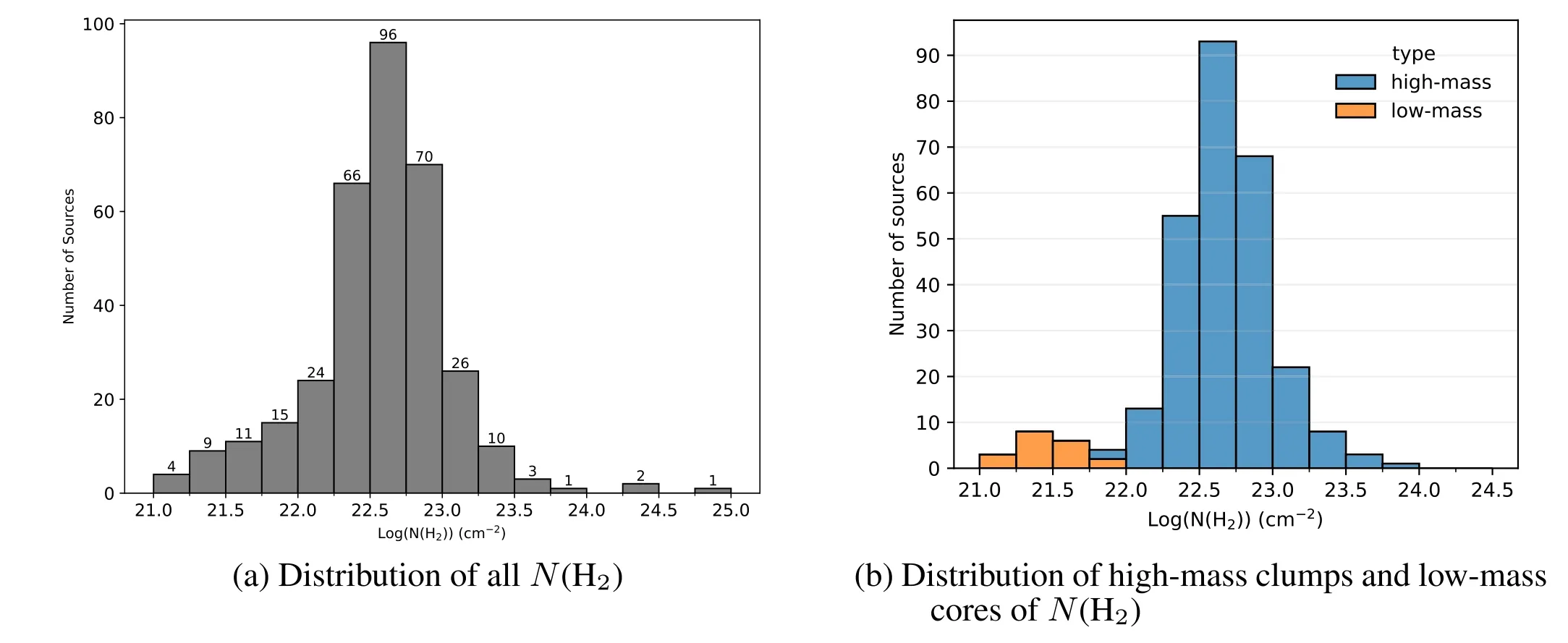
Figure 3. Distribution of H2 column density

Figure 4. Distribution of H2 column density for high-mass clumps at different evolutionary stages.
3.3. Column Density
Figure 3(a)shows the H2column densityNH2distribution of all sources with valid values given in the literature.The column density of H2ranges from 1.2×1021to 9.8×1024cm-2,with a median value of 4.17×1022cm-2. Figure 3(a) shows thatNH2is not log-normally distributed. Figure 3(b) gives the column density distributions of low-mass and high-mass sources. It can be seen that theNH2distribution of low-mass cores and high-mass clumps is significantly separated. Their median values are 2.6×1021and 4.8×1022cm-2, respectively. Among them,there are few samples of low-mass cores,so its distribution has little significance.For high-mass clumps,the distribution has a threshold of 1022~1024cm-2, which is consistent with the literature(Rygl et al.2013;He et al.2016).Figure 4 presents the distribution ofNH2for high-mass clumps at different evolutionary stages. The median values for highmass are 3.1×1022,4.7×1022,5.4×1022cm-2for prestellar,protostellar, H II, respectively. Taking into account that the corresponding rms are 0.18,0.28,0.35 in the case of logarithm,respectively, the column density of H2increases slightly with the evolutionary stage. Different methods for calculating column density are used in different papers, the results of column density calculated using different molecular lines are different based on abundance ratios to hydrogen molecules.
3.4. The Skewness Parameter
As stated in the introduction, the infall motion is signatured by the spectral line asymmetry of optically thick line and a single-peaked profile (Leung & Brown 1977; Zhou 1992;Mardones et al. 1997; Evans 1999; Lee et al. 1999). To demonstrate the measure of asymmetry,Mardones et al.(1997)defined a non-dimensional parameter δV

where Vthickand Vthinare the velocities of the peaks of optically thick and thin lines. ΔVthinis the line width (FWHM) of the optically thin line. The values δV obtained from different line pairs may be different. When δV ≤-0.25 or δV ≥0.25, it can usually be considered that the source has a significant blue or red profile.
Different molecules may give different result in studying infall.Mardones et al.(1997)observed 47 protostars to identify infall sources with H2CO (212–111) and CS (2–1), and found that the fraction of blue profiles decrease from Class 0 to Class I. However, Gregersen (1998) observed a larger sample which includes the Class I sources of Mardones et al. (1997),but did not find such trend using HCO+(3–2). Fuller et al.(2005) observed HCO+J=1-0, J=3-2, J=4-3, and H2CO (212–111) toward 77 850 μm continuum sources, and suggests HCO+(1–0) and H2CO (212- 111) trace infall more effectively than HCO+(3–2) and HCO+(4–3). Rygl et al.(2013)used HCO+(1–0),HCO+(4–3)and CO(3–2)to observe another sample of high infrared extinction clouds, came to a similar conclusion. Therefore, the δV values derived from HCO+(1–0) and H2CO (212–111) are given with high priority.
Figure 5 shows the distribution of 429 valid δV values of all sources. Although δVs are calculated from different lines, we believe this distribution has its scientific significance since the large proportion is identified with HCO+(1-0). The median value of δV for all sources is-0.52.For high-mass clumps,the median value identified with HCO+(1-0)is-0.50.In contrast,Rygl et al. (2013) derived -0.64 with the same line. For lowmass cores, Figure 6 presents the δV distribution of different evolutionary stages. The median values at stages of prestellar and protostellar are -0.46 and -0.74, respectively. Considering the corresponding rms are 0.16 and 0.33 respectively, the blue asymmetry may have no difference with evolution of lowmass cores. Further observations are needed because of the small sample size. As Figure 7 shows, the δV of high-mass infall clumps are -0.55, -0.52, -0.47 at the stage of prestellar, protostellar and H II region respectively. The rms are 0.23, 0.29, 0.25, respectively. It seems that the blue asymmetry of high-mass infall clumps have the same trend as those of low-mass.
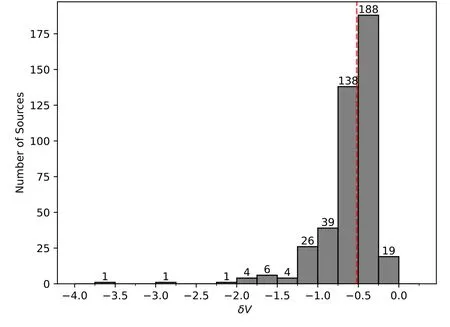
Figure 5. Distribution of δV for all sources given in the literature. The red dotted line represents the median value of δV.
3.5. Infall Velocity
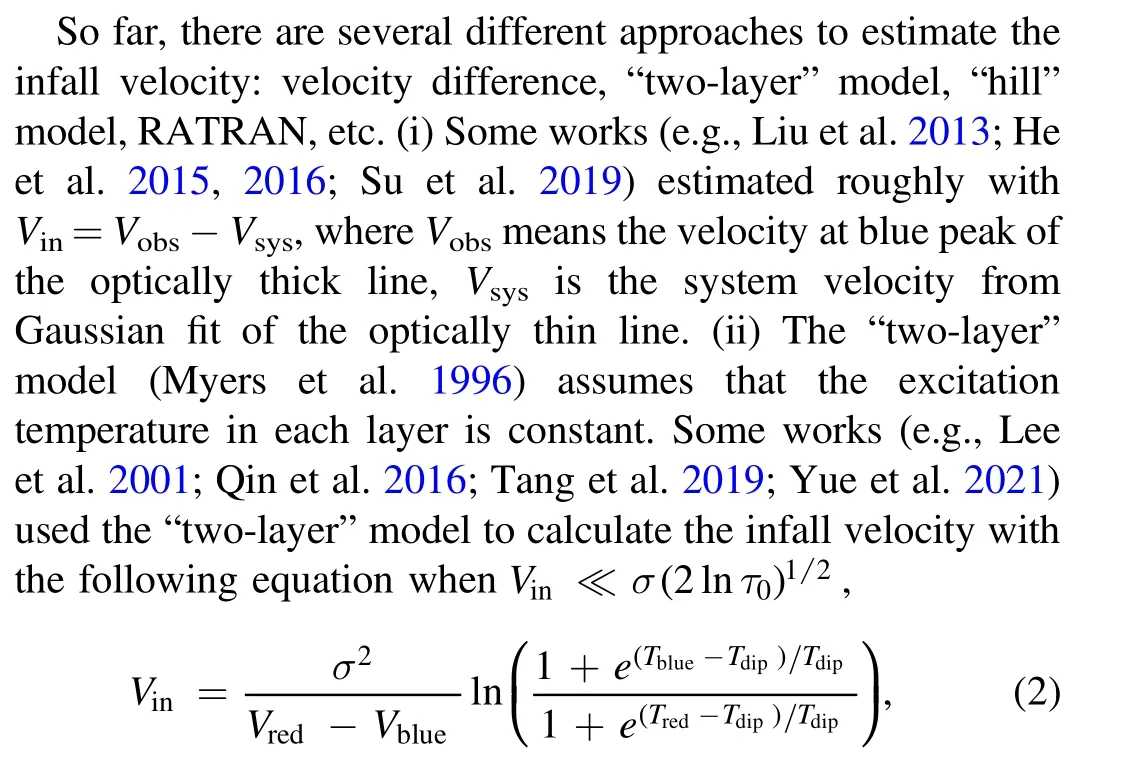
where Vblueand Vredare the velocities of the blue and red peaks of optically thick line,Tblueand Tredare the corresponding peak intensities, Tdipis the intensity of self-absorption dip between the two peaks,and σ is the velocity dispersion of optically thin line. (iii) The “hill” model assumes that the excitation temperature is increase inward as a linear function of optical depth (De Vries & Myers 2005). De Vries & Myers (2005)thought that the “two-layer” model underestimates the infall velocity by a factor of ~2 when matching the two-peak profiles while the“hill”model matches better with an rms error of 0.01 km s-1. Blue-asymmetric line profiles with shoulder or redshifted peak cannot generally well fitted by the “two-layer”or “hill” model. (iv) A more complex model is RATRAN,which uses 1D Monte Carlo radiative transfer code (Hogerheijde&Van Der Tak 2000)to construct the infall model with more input parameters,such as the radius,mass,density profile,turbulent velocity, kinetic temperature distribution, and the abundance of the molecule. This model can better constrain infall velocity than the“two-layer”model(Peretto et al.2013).The infall velocities derived by different approaches are relatively uniform and will not have a significant impact on the statistical results.
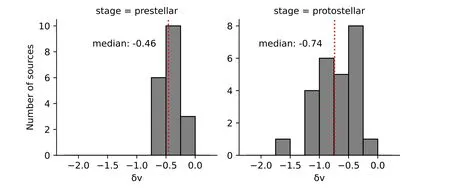
Figure 6. Distribution of δV for low-mass cores. The red dotted line represents the median value of δV for each stage.
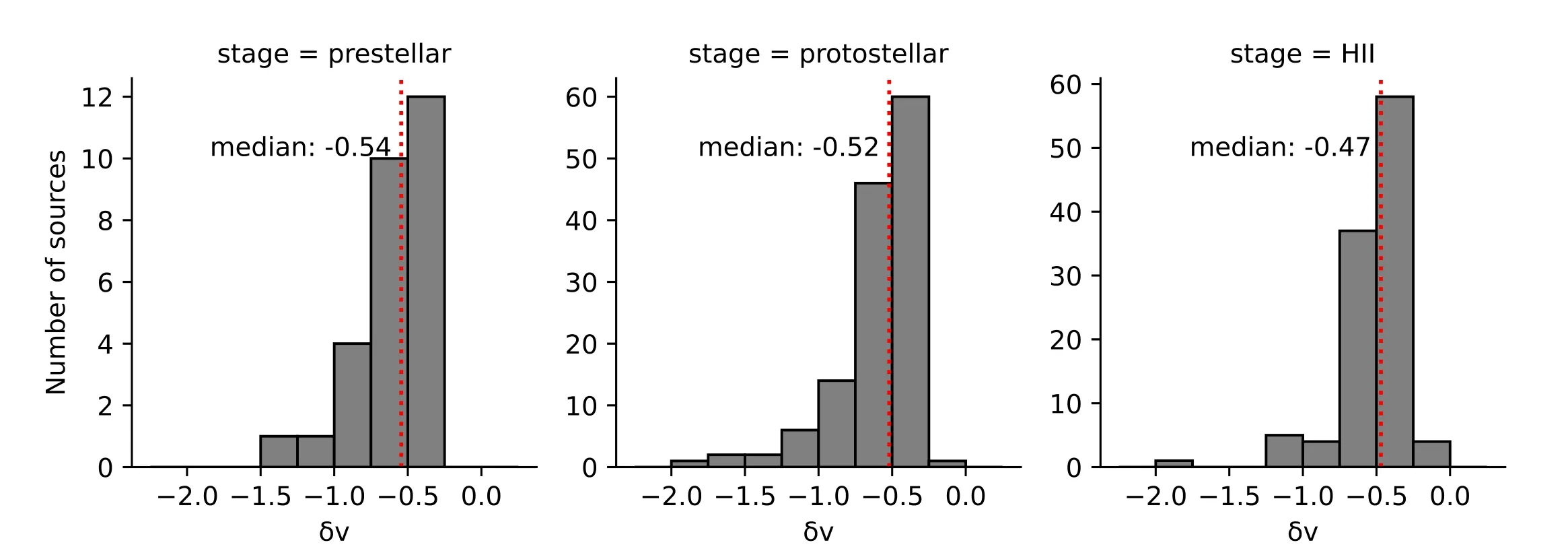
Figure 7. Distribution of δV for high-mass clumps. The red dotted line represents the median value of δV for each stage.
Figure 8 shows the distribution of infall velocities for 354 sources provided in the literature.We give the fitting of lognormal distribution(blue dashed line). The parameters are marked in the upper right of the figure. Kolmogorov-Smirnov (KS) test shows the P value is 0.31.The median value(red dotted line)is 0.97 km s-1. The infall velocity varies with tracers and position across each core(Keown et al.2016).Liu et al.(2013)believes that infall velocity may be related to the stage of evolution. In order to further study this,we conduct research according to different type of mass and stages. Figure 9 shows the distribution of infall velocity to different evolutionary stages of low-mass cores. The Vinof almost all low-mass sources are less than 0.5 km s-1.This is rather different from the result of Liu et al.(2013),which shows the typical infall velocities in low-mass star-forming regions are~0.5 km s-1. The median values of prestellar and protostellar stage are 0.05(±0.04)and 0.17(±0.20)km s-1,suggest that Vinmay not change with evolution for low-mass cores.However,this result should be interpreted with caution and await further investigation. KS test assumes that the distribution of these two stages is consistent,and the P value is 0.013,rejecting the original hypothesis.

Figure 8. Distribution of infall velocity. The red dotted line indicates the median value. The blue dashed line is the fitting of lognormal.

We have also analyzed the influence of different spectral lines on the infall velocity of the sources.The lines adopted by at least 15 sources are used for the following statistics. They are:HCO+(1–0),CO(4–3),CS(2–1).For the cores with valid Vinvalues,only CS(2–1)meets the statistical requirement.The median value is 0.05 (±0.04) km s-1, which is basically consistent with the median value 0.07 km s-1of all low-mass cores. This result may change as the sample number of lowmass cores increases. For high-mass clumps, The median values estimated by HCO+(1–0) and CO (4–3) are 1.03(±0.85),3.21(±1.45)km s-1,respectively.The number of Vinestimated by HCO+(1–0) accounts for more than 90%, and is thus close to the median value 1.06 of all the high-mass clumps. The sources using CO (4–3) to derive Vinare all from Yue et al. (2021).
On the other hand, Rygl et al. (2013) calculated the source(G014.63–00.57 MM1) and showed that the Vinderived from HCO+(1–0) is about twice as large as that derived from HCO+(4–3),but he thought the value derived from HCO+(1–0)was overestimated.Saral et al.(2018)used two lines(HCO+and HNC)to estimate infall velocities of the same three sources,the results were similar taking into account the error. Tang et al.(2019) estimated Vinof one source (G192.16–3.84) with C18O(2–1) and HCO+(3–2), indicating that the result derived from HCO+(3–2) is slightly larger than C18O (2–1). It can be seen that,due to the lack of total samples,we are temporarily unable to systematically study the influence of different spectral lines on the infall velocity.
3.6. Mass Infall Rate

Figure 11 shows the distribution of mass infall rate of the sources provided in the literature.We could see from the figure that the distribution can be divided into two parts, this separation comes from the different types of mass. Among them, we do not know the distribution of low-mass cores because of fewer samples,but for high-mass clumps,it presents an evident lognormal distribution with the P value of 0.82 of KS test. The range of mass infall rate for low-mass cores are 10-7–10-4M⊙yr-1, and almost all high-mass clumps are 10-4–10-1M⊙yr-1with only one exception.This is consistent to previous work in high-mass star-forming regions range between 10-4–10-2M⊙yr-1(e.g., Wu et al. 2009; Qiu et al.2012;Liu et al.2013;Qin et al.2016),which are far larger than that of low-mass sources (Beuther et al. 2005; Padoan &Haugbølle 2014; Kim et al. 2021).
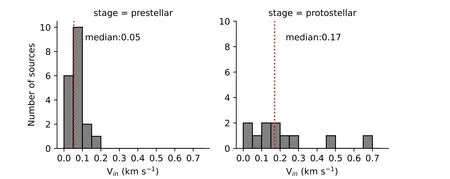
Figure 9. Distribution of infall velocity at different evolutionary stages for low-mass cores. The red dotted line represents the median value for each stage.

Figure 10.Distribution of infall velocity for high-mass clumps at different evolutionary stages.The red dotted line represents the median value of Vin for each stage.
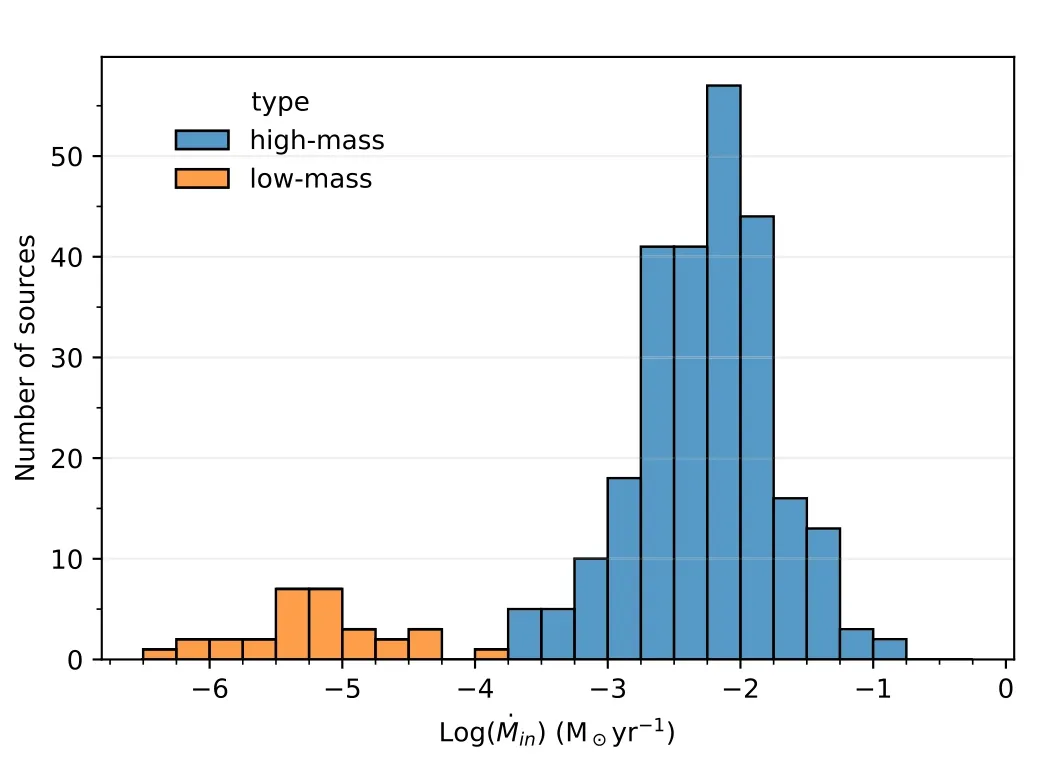
Figure 11. Distribution of mass infall rate provided in the literature.
Padoan&Haugbølle(2014)proposed that in most cases,the ˙Minis initially the order of 10-5M⊙yr-1, and may decay rapidly when forming low-mass stars, or maintain relatively large when forming massive stars.Yue et al.(2021)concluded that mass infall rate is independent of the evolutionary stage.Figure 12 shows the distribution of mass infall rate for sources at different evolutionary stages. The orange represents lowmass cores and the blue represents high-mass clumps. The median values of ˙Minat each stage for low-mass cores are 6.03(±0.41)×10-6and 6.46 (±0.77)×10-6M⊙yr-1respectively,and for high-mass clumps are 2.63 (±0.46)×10-3, 6.76(±0.41)×10-3, 7.24 (±0.61)×10-3M⊙yr-1respectively.Each of them is in the same order of magnitude. We do not find that the mass infall rates of either high-mass or low-mass sources change significantly with evolutionary stages.Note that due to the small number of samples, especially low-mass samples, we need more research to discuss the trend. In addition,the error of distance may also have some influence on the statistical results.
3.7. Association with Masers and Outflows

Figure 12. Distribution of mass infall rate for sources at different evolutionary stages. Orange represents low-mass cores and blue represents high-mass clumps.

Table 4 The Maser Association Rate of Sources with Different Masses
Infall motion is a part of the initial activity of star formation,and maser is also a common phenomenon in star-forming regions. Class I CH3OH masers are usually associated with outflow because of the collisional pumping mechanism, while class II CH3OH masers generally occur in compact regions and possibly associated with massive star-forming regions due to the mechanism of radiative pumping. In order to study the correlation,we matched the summarized infall sources with the existing maser database (https://maserdb.net).
If a master source is found within 1′ of the infall source, we think that they are associated.Table 4 gives the association rate between sources and masers with different types of mass.There are 208 sources being associated with masers, the association rate is 46%, and the number for high-mass and low-mass sources are 190 of 352(54%)and 10 of 54(19%),respectively.The number associated with masers of Class I CH3OH,Class II CH3OH,H2O,and OH are 130(29%),122(27%),165(36%),75 (16%), respectively. We find that the association rates between high-mass sources and the four kind of masers are generally greater than those of low-mass.This may indicate the star formation activity near massive sources is more intense.In addition, we can see that there are no low-mass sources associate with class II CH3OH maser, which is consistent with the conclusion that the class II CH3OH maser is only associated with the massive star-forming region. Of the four masers, the association rate of H2O is slightly higher, and that of OH is lower for both high-mass and low-mass sources. This may be related to the fact that the samples are not unbiased.
In the early stages of star formation, collapse and infall motion are often accompanied by molecular outflows (Li et al.2014).The study of the relationship between infall and outflow is helpful to better understand the activity mechanism of star formation. Therefore we also matched these sources with outflows provided in some literature (Wu et al. 2004; Maud et al.2015;Li et al.2019;Zhang et al.2020)in the range of 2′.There are 52 (11%) sources being associated with outflows,which is shown in Table A.1 in the Appendix. Part of the reason for the low association rate may be that the outflow samples are incomplete.
4. Summary
We searched the literature related to infall study since 1994,summarized infall sources and made some statistics on the physical properties. The result is summarized below.
1. A total of 456 sources have been cataloged,including 352(77%) sources with high mass, 55 (12%) with low mass,and the remaining 49 (11%) cannot be categorized. We further divide the high-mass sources into three groups according to the evolutionary stage, that is prestellar,protostellar,H II region.The number in the groups are 48(11%), 215 (47%), 125 (27%), respectively. The remaining 69 (15%) sources have no evolutionary information.Most of the sources are located within 5 kpc from the Sun. We divide the sources into clumps and cores according to their sizes.Vast majority(97%)of the highmass sources are clumps, and most (85%) of the lowmass sources are cores.Although the current observations are far from complete, the present evidence shows that the star formation activity within the solar circle is more intense than the outer.We summarized the optically thick lines utilized to identify the infall signatures. About 77%of infall sources are identified with HCO+(1-0),suggested this line is more effective in identifying infall sources than the others.
2. The H2column densities of high-mass clumps ranges between 1022and 1024cm-2, and those of low-mass cores are about 1021cm-2. The median value of highmass clumps is 4.8×1022cm-2, which is one order of magnitude higher than that of low-mass cores.
3. We counted the skewness of sources and classified them according to different mass and evolutionary stages,but it does not show significant differences with the mass and evolutionary stage.
4. The median value of infall velocities (Vin) for high-mass clumps is 1.12 km s-1with the rms 1.02, and the Vinof nearly all low-mass cores are less than 0.5 km s-1.There is no evidence that infall velocity changes with evolution.
5. The range of mass infall rates for low-mass cores are 10-7~ 10-4M⊙yr-1, and for high-mass clumps are 10-4~10-1M⊙yr-1with one exception.We do not find that the mass infall rates change with evolutionary stages for either high-mass or low-mass sources.
6. There are 208 (46%) sources being associated with masers within an angular radius of 1′. The number of infall sources being associated with masers of Class I CH3OH, Class II CH3OH, H2O, OH are 130 (29%), 122(27%),165(36%),75(16%).There are 52(11%)sources being associated with outflows within 2′.
Acknowledgments
This work is supported by the National Key R&D Program of China (Grant No. 2017YFA0402702), and the National Natural Science Foundation of China (NSFC, Grant Nos.11873093 and U2031202). Z.C. acknowledges the support from the NSFC (Grant No. 11903083).

Table A.1 An Excerpt of the Physical Properties of Infall Sources

Table A.1(Continued)
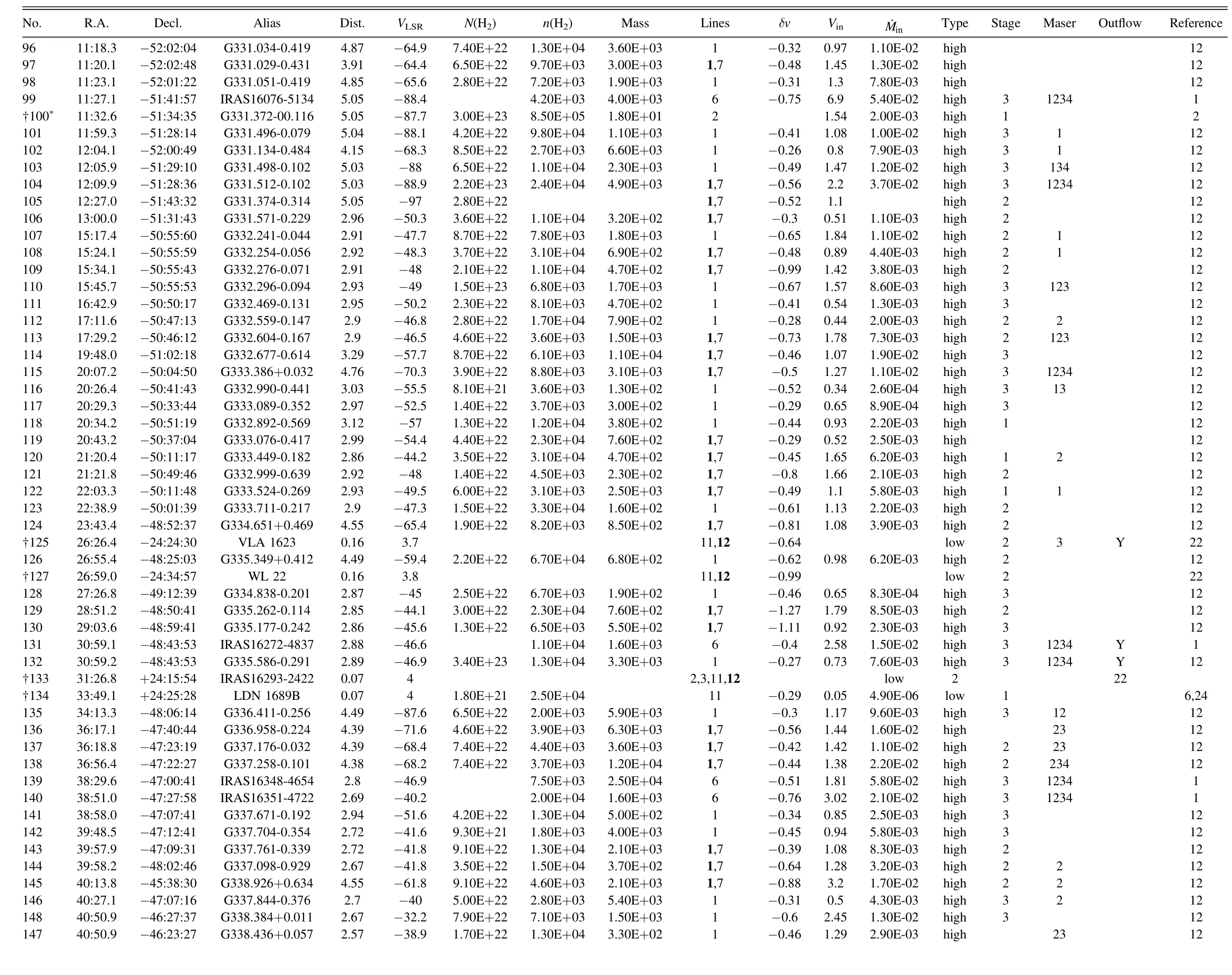
Table A.1(Continued)
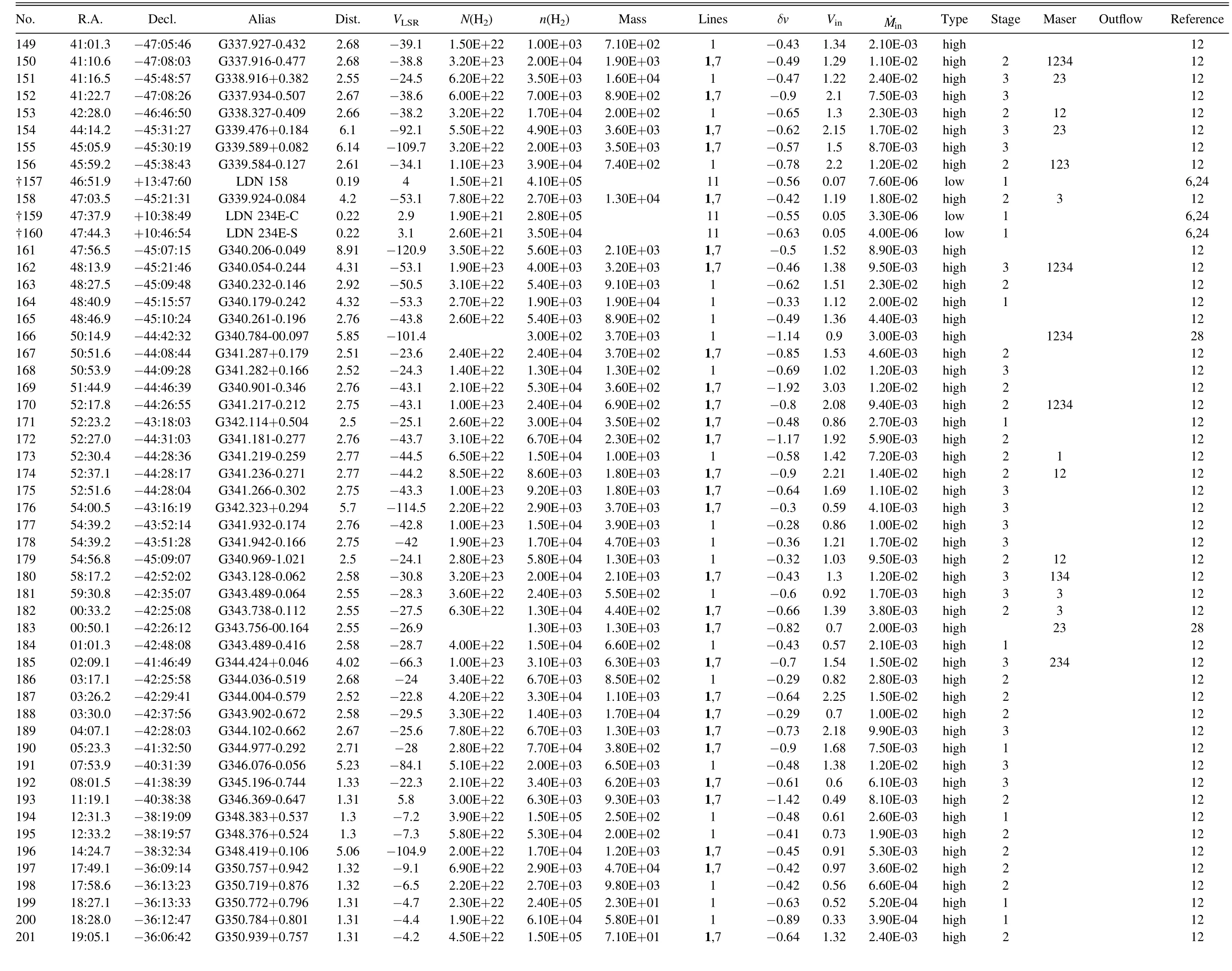
Table A.1(Continued)

Table A.1(Continued)
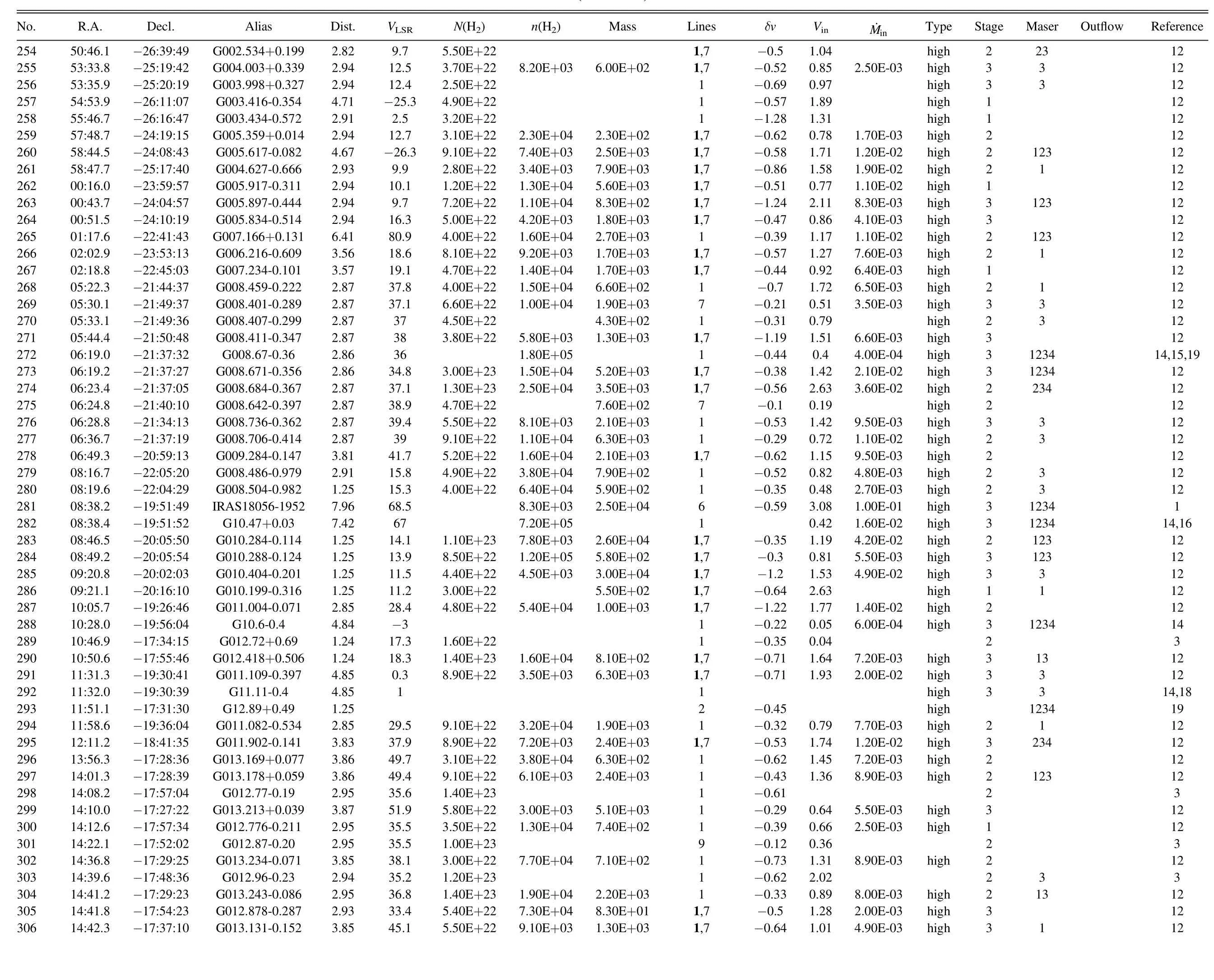
Table A.1(Continued)
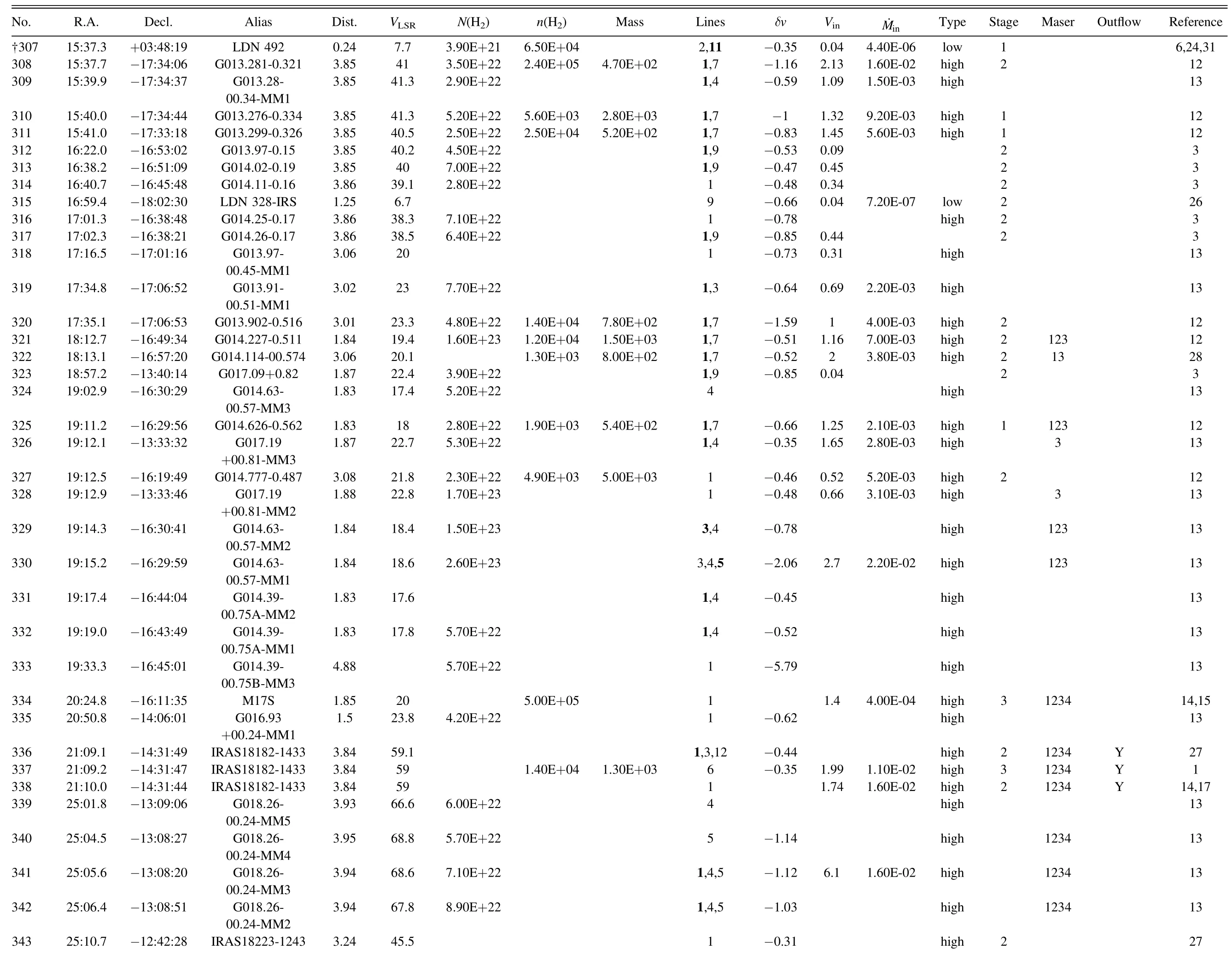
Table A.1(Continued)
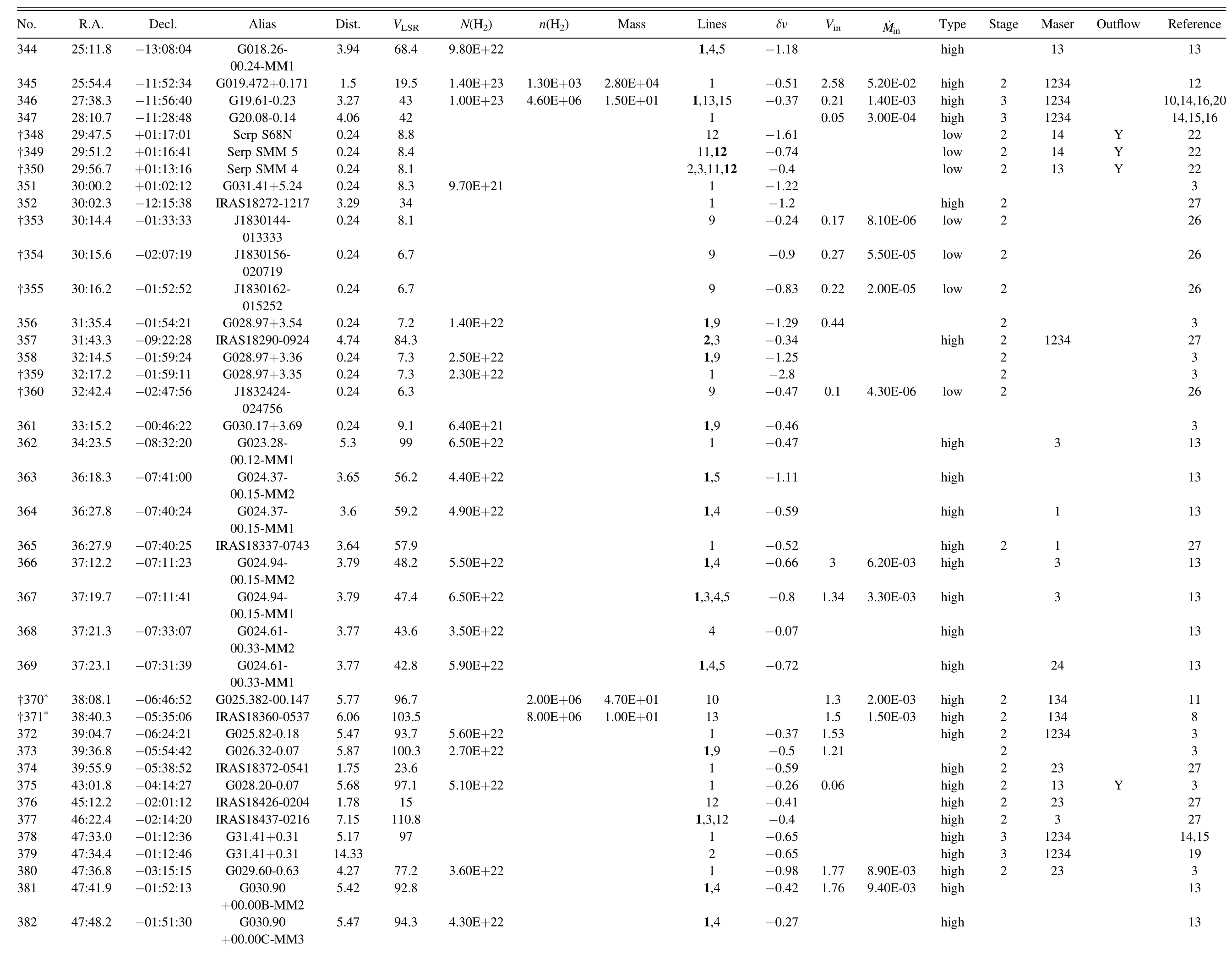
Table A.1(Continued)
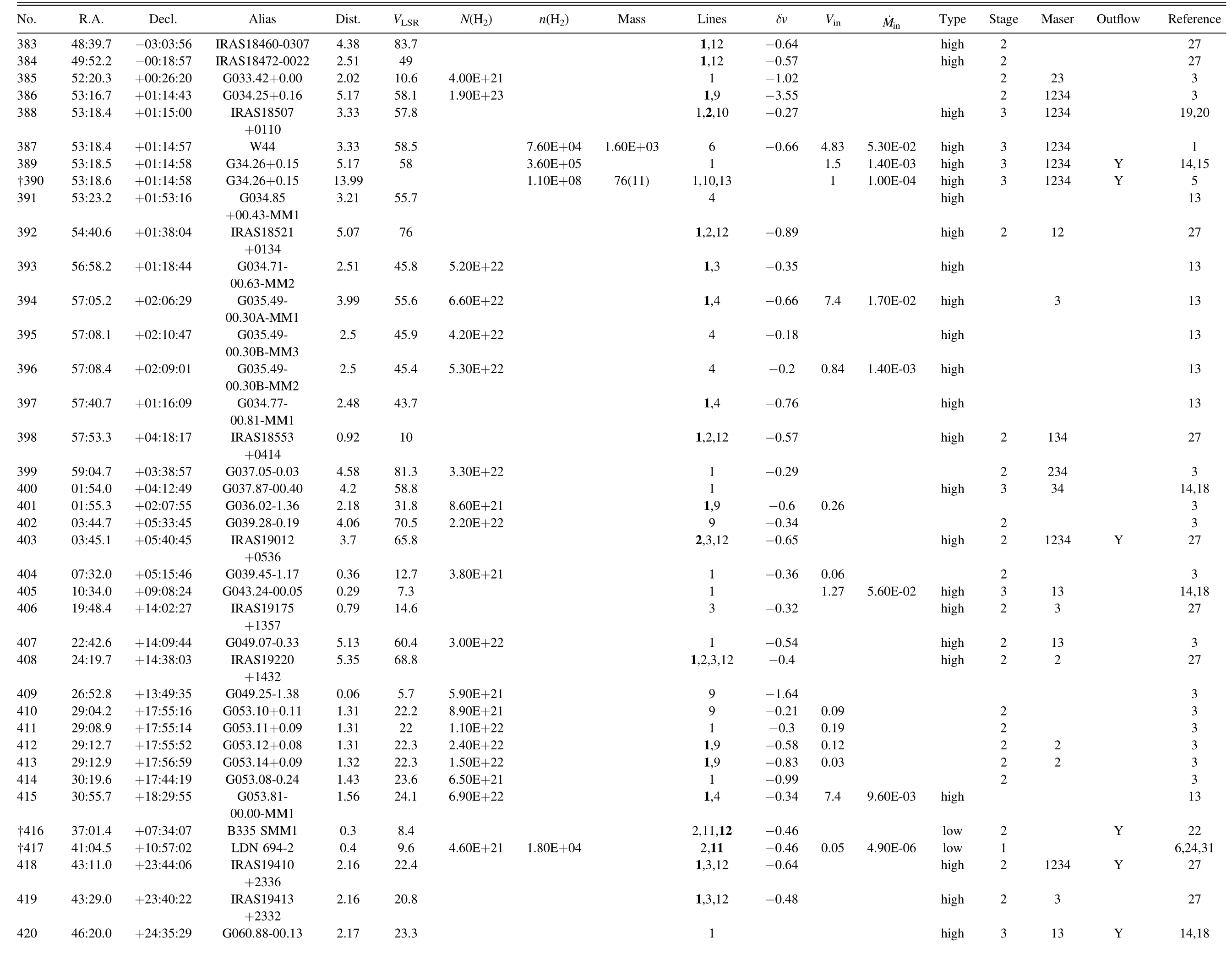
Table A.1(Continued)
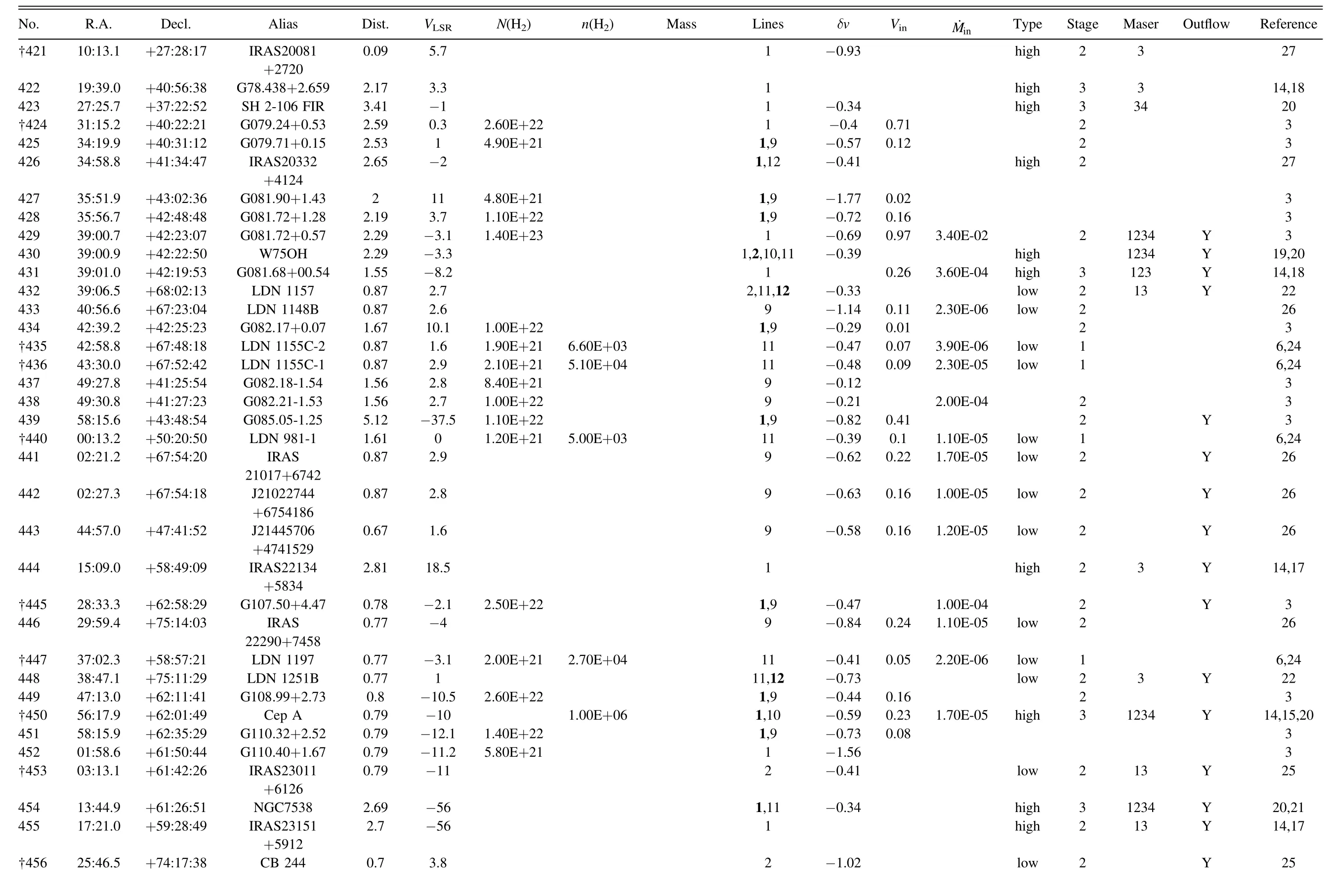
Table A.1(Continued)
Appendix
All Collected Infall Sources
Table A.1 is the complete version of table 3.See section 2.2 for details of each column.
ORCID iDs
Shuling Yu (于书岭) https://orcidorg/0000-0002-8617-3521
Zhibo Jiang (江治波) https://orcidorg/0000-0002-
5920-031X
Yang Yang (杨旸) https://orcidorg/0000-0002-2895-7707
Zhiwei Chen (陈志维) https://orcid.org/0000-0003-
0849-0692
Haoran Feng (冯浩然) https://orcidorg/0000-0003-1714-0600
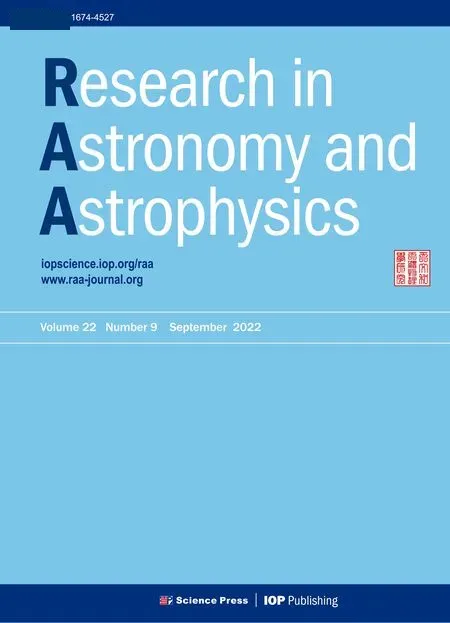 Research in Astronomy and Astrophysics2022年9期
Research in Astronomy and Astrophysics2022年9期
- Research in Astronomy and Astrophysics的其它文章
- The Quasar Candidate Catalogs of DESI Legacy Imaging Survey Data Release 9
- A Photometric Study of Two Contact Binaries:CRTS J025408.1+265957 and CRTS J012111.1+272933
- Investigating the UV-excess in Star Clusters with N-body Simulations:Predictions for Future CSST Observations*
- Detection of 16 Small Glitches in Nine Pulsars
- Investigations of Thermal Deformation Based on the Monitoring System of Tianma 13.2m VGOS Telescope
- Simulation Study of Network Reconfiguration and Load-balancing Method for the Xinjiang Astronomical Observatory Data Center
